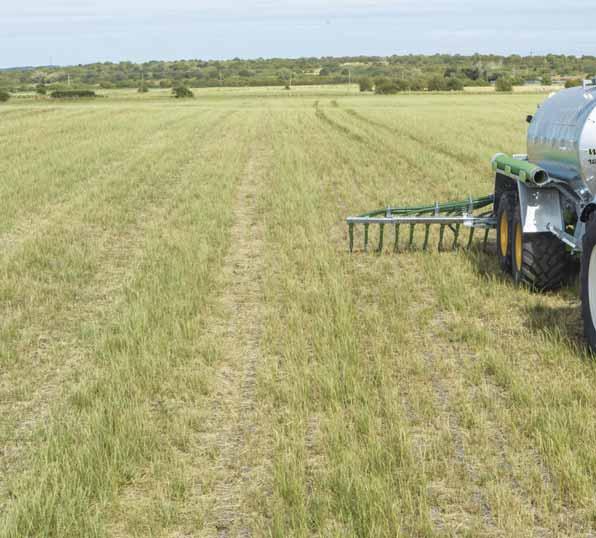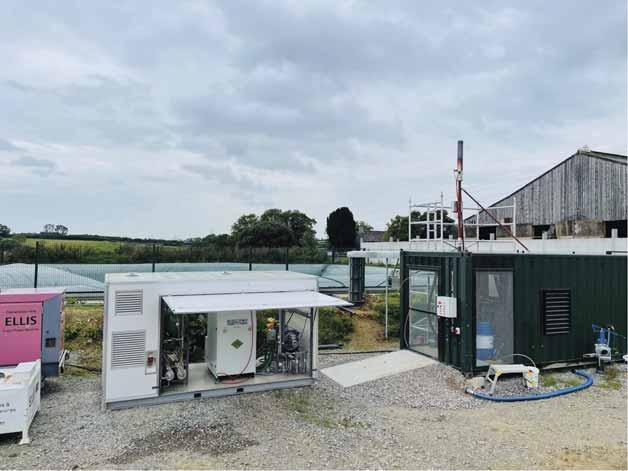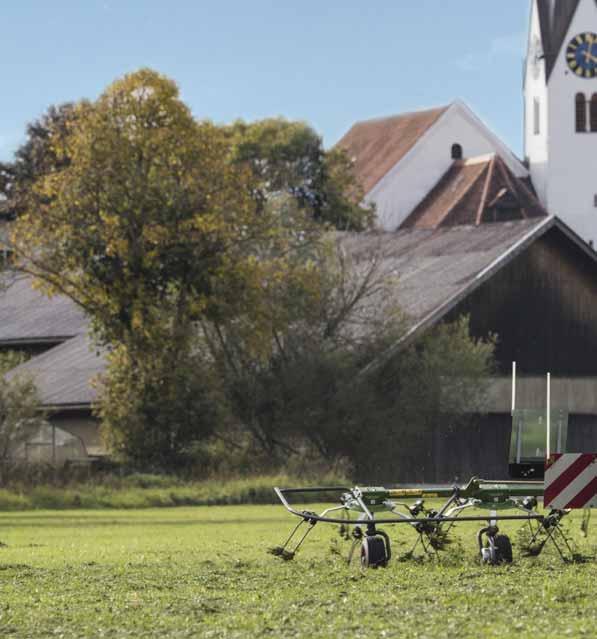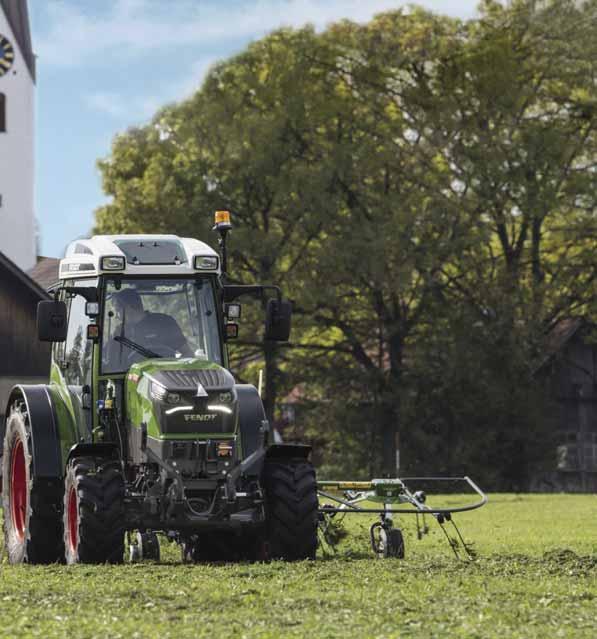
11 minute read
Practice – Future fuels
Landwards Conference 2021
Alistair Walshaw
Advertisement
Future Fuels in Agriculture
The Institution’s annual conference was delivered virtually again this year, on Wednesday 3rd November and focused on alternatives to carbon-based fuels for farming. A range of expert speakers took delegates through the options.
Making the most of a waste
Farming has a significant chance to reduce its carbon footprint by converting methane, a green‐house gas many times more dangerous than carbon dioxide, into a valuable asset.
Livestock production generates a significant volume of methane, but the sector has a unique ability to capture most of that gas and use it as a fuel, suggest researchers. While other alternative fuels have been discussed, tested and experimented on, methane has several key advantages over them.

The methane tractor
Firstly, the technology is already available – with CNH’s first commercially available methane farm tractor due off the production line soon.
And the technology to harvest methane produced on most livestock farms is already available.
Delegates tuning in to the Institution of Agricultural Engineers’ autumn conference, heard that the first methane powered tractors would be rolling off CNH’s Basildon production line in December 2021.
The company has developed the concept, building on work done by its partner company Iveco, CNH’s Alistair Walshaw told the audience. Iveco now runs fully methane powered lorries of up to 460hp, having started work on the concept in the mid‐1990s.
Energy density challenges
One drawback is that diesel is five times as ‘energy dense’ as methane. So while a normal tractor might run all day on a 150 litre tank, the equivalent methane‐powered machine would consume 750 litres in the same time.
Using methane as a fuel would reduce a range of emissions, he says, and the source of the fuel – livestock slurry – is widely available across the country.
By contrast, other alternative fuels could not be widely adopted until a significant rural supply network had been developed.
Landwards Conference 2021

Chris Mann
Fuel from slurry
Among the companies leading the development of fuel production is Bennamann, which has established a research base on a Cornish dairy farm.
Dr Chris Mann, from the company, says their system completes a very virtuous circle:
“We are managing waste and turning a powerful greenhouse gas into a green fuel. A lot of methane is being lost from slurry lagoons.”
If it were harvested, he says, farmers could meet all their own energy needs and be able to sell the surplus. To harvest methane contained in ‐ and normally released gradually to the atmosphere from ‐ slurry, his company has developed a patented chamber that covers and seals the lagoon.
The gas is processed into a liquid that can be used as a fuel by a range of engines.
The only emission, when it is burnt, is a volume of carbon dioxide equivalent to that absorbed by the grass when it grew.
The remaining digestate from the slurry pit can be applied to the ground like normal slurry, returning the nutrients it contains to the soil. Chris says the system is suitable for use on any dairy unit of 50 or more cows.
While the company’s storage system is twice as expensive as conventional systems, the income from harvested methane normally achieves payback in four to six years.
Deutz launches the TCG 7.8 H2, the company’s first hydrogen engine. The drive, which meets all the eligibility criteria set by the EU for zero CO2 emission engines, is a further addition to the company’s portfolio of low‐emission and zero‐emission drive systems. “Deutz are pioneers of carbon‐neutral drive systems for off‐highway applications. We already manufacture clean and highly efficient engines. Now we are taking the next step: Our hydrogen engine is ready for the market. This represents an important milestone that will help us to make our contribution toward the Paris climate goals,” says Dr. Frank Hiller, CEO of Deutz AG. The hydrogen‐powered engine has performed on the test bench with flying colours and is scheduled to go into full production in 2024. Dr. Markus Müller, Chief Technology Officer of Deutz AG, explains: “The six‐cylinder TCG 7.8 H2 is based on an existing engine design. Generating a power output of 200 kW it runs carbon‐neutral and very quietly. In principle, the engine is suitable for all current Deutz
We still need big machines applications, but due to the available infrastructure it is likely to be used first in stationary equipment, Farmers will still need big machines to produce the generators, and rail transport.” nation’s food – and that machinery will need a reliable power source. That was the message from Paul Hemingway, President of IAgrE, while opening the Institution’s autumn conference, entitled ’Future Fuels in Agriculture’. While much media coverage recently has predicted a future in which farm machinery might become smaller, Mr Hemingway says larger machines might still be needed. In some circumstances the need for them might grow: “Climate change means weather windows are getting shorter. “Therefore, we will need to use big tackle and need energy sources that are environmentally friendly and enable us to operate in remote locations for long periods.” And the industry would continue to need glasshouses to extend growing seasons and meet food demand.

Paul Hemingway First pilot project with customers in the pipeline
The hydrogen engine’s first pilot application will be in stationary equipment for power generation in partnership with a regional utility company. The pilot is scheduled to commence at the beginning of 2022 with the aim of demonstrating the engine’s suitability for everyday use.
No silver bullet
There is no ‘silver bullet’ solution to farming’s need for new fuels to power field vehicles, Jarno Ratia, engine specialist with AGCO told the conference.
Instead, he suggests different sectors of industry will find solutions most appropriate to them.
Meanwhile, farmers can expect the emissions of existing and future machines to be gradually ratcheted down.
And to put the whole debate in context, he pointed out that Allis Chalmers first developed a 20‐horsepower fuel cell tractor in 1959, and that concept had been widely examined before that. When considering alternative fuels, like electricity and hydrogen, he said that smaller machines handling lighter tasks appeared to be the most likely to ‘go electric’. Larger machines with higher power requirements were more likely to benefit from developments in hybrid power units.

AGCO ‐ Jarno Ratia
Landwards Conference 2021

Going electric
There were benefits to going fully electric, he noted, with Fendt first showing its E‐Vario model at Agritechnica some years ago, and the machine is due to go on sale soon. Using electric power would satisfy exhaust emission regulations, and electricity was currently cheaper than fossil fuels due to taxes on the latter.
Going electric would also facilitate greater levels of autonomy, which might enable farmers to access a faster machine that did not require a driver. Using an electric motor would also have benefits – notably in dispensing with the high noise levels of a conventional combustion engine:“It would also dispose of the cooling package required for a combustion engine.”
For heavy duty electric tractors, acheiving sufficient battery 'energy density' is a challenge.

Battery capacity
The technology was still relatively young and achieving high enough ‘energy density’ remained an issue, although he expects the capacity of batteries to increase two or threefold over the next few years. But that would still leave electricity lagging behind other fuels in terms of energy density.
Hydrogen simplicity?
Hydrogen could present a simpler solution, most notably because the technology to use it already exists.
It also meets environmental challenges, because the only emissions are water vapour and a few particulates. But while hydrogen fuel cells were very quiet, they require significant cooling, something he suggested might limit their potential market.
One other issue is that they are most efficient when subjected to less than 50% loading – something that, he suggested, might make them impractical in many farming applications.
The immediate development of hydrogen as a fuel for farming and the countryside are limited by lack of a supporting infrastructure.
While it could be expected to develop in the next 20 years, he said localized production was an option, but that it would require significant investment from the farmer or estate looking to adopt the technology.
Energy storage issues
To illustrate the energy storage issue, he presented figures comparing how much of four different fuels might be needed to complete eight hours of ploughing.
Conventional diesel was compared against hydrogen being burned through a conventional diesel engine; hydrogen being used to power a fuel cell and electric power via a battery.
Diesel is the most ‘energy dense’ fuel, with 179 litres of fuel lasting a whole day and weighing 152 kilogrammes, with the storage tank typically costing under one thousand Euros.
The hydrogen required to do the same work via an internal combustion engine would only weight 53 kilogrammes, but would be 3,200 litres, with the storage vessels costing some 30,000 Euros.
The figures for hydrogen being used in a fuel cell were very little different: 49 kilogrammes weight of fuel would be needed, which would mean 2,600 litres of fuel and a storage tank costing some 25,000 Euros.
By contrast, the figures for electric batteries are eye‐opening: the
batteries required to do eight hours work would weight 4.1 tonnes –containing the equivalent of 3,400 litres – and costing some 150,000 Euros.
While electricity was now being used to power lorries on the road, he pointed out that agricultural vehicles faced different challenges and would need different solutions.
Jon Swain
Horticulture
While many industries are examining ways to minimise their carbon dioxide emissions, horticulture has a rather different issue, says Jon Swain, technical director of NFU Energy.
The sector needs a huge amount of energy to produce heated and lit crops. It also needs good CO2 supplies for glasshouse enrichment to help crops grow.

Horticulture needs huge amounts of energy and good CO2 supplies.
But industry could still help farming work towards its ‘net zero’ targets:
“Getting to net zero means reducing emissions and then doing something about emissions that are unavoidable.”
Farming’s main greenhouse emissions were nitrous oxide from livestock (40% of total emissions) and methane from animals (50%), with carbon dioxide from across the industry accounting for the remaining 10%.
He suggests the industry could reduce its emissions by adopting systems which help capture carbon, and by ensuring systems are as efficient as possible and by making productivity improvements.
The CO2 conundrum
Horticulture has a significant reliance on gas for powering boilers as well as heat and combined power plants:
“We already have relatively low emissions other than CO2, but we also produce CO2 used to enrich glasshouses to promote growth and optimise yields.
“The problem we might have moving forward is that if no CO2 is available for enrichment then we would need another source.”
Horticulture uses a lot of energy to illuminate crops to trigger photosynthesis to extend growing seasons and enable them to be grown ‘out of season’.
Using renewable energy sources could help industry halve emissions involved in lit crop production and reduce that of un‐lit crops by some 90%, he suggests.
The sector needs to think creatively about using different heat sources and decarbonizing its practices; but he warns that many facilities don’t have sufficient land available:
“Bio‐energy does have a role to play and can provide a way of reducing carbon emissions relatively quickly.”
Savings could be made if the location of both glasshouses and factories producing heat were re‐imagined:
“If we could move horticultural production to places where heat and CO2 are both available, we could benefit from that. We could also look at how to capture methane.”
In that respect horticulture has an advantage over livestock, he suggests, because its facilities are generally closed.
By contrast livestock buildings are designed to be well ventilated.
Energy reduction first
He believes farming needs to aim to reduce its use of power considerably as a first step, before moving on to consider alternative energy sources.
And glasshouses of the future could look very different to those used today, with a potential that they might be vertical farms, sealed boxes.
Whatever form it took, the sector needed to be as efficient as possible in its use of power, or risk having decisions on such issues made outside the industry.
Seeking out renewables
Alternative power is already being widely adopted among LEAF members, the organisation’s CEO Caroline Drummond said when opening the conference.
The effects of climate change were already being felt with rainstorms, hailstones and wildfires affecting farming, wildlife and the public’s lives.
Many LEAF members had responded to growing threats of climate change and were reducing their reliance on fossil fuels, with some 67% using at least one form of renewable power on their farm.
And they were also addressing their emissions, with 39% of them using tools to assess their carbon footprint.
Using such tools may become a requirement of the LEAF Marque standard in future, she added. And while much of the focus was on cutting the size of the livestock industry, she highlighted its role in farming’s future:
“As everybody strives for more regenerative and integrated approaches, livestock and the manures it produces play a really important role in improving soil health and structure.
“We should also stress the rich and varied biodiversity of grassland, which is also very good for carbon capture.”
She adds that much of the data being quoted about livestock comes as a ‘snapshot’ of the industry rather than a full industry analysis.
Watch again
on the IAgrE YouTube channel
https://bit.ly/3kpKVF8










